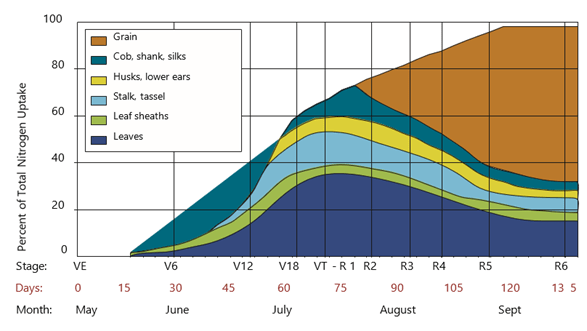Spring Applied Nitrogen
BY Dairyland Seed Agronomy Team
With some areas experiencing a later harvest and soggy fall conditions, not all planned fall nitrogen applications happened. In order to have the required amount of nitrogen for the crop, more nitrogen applications will be made in the spring or split applied. Whether you typically apply your nitrogen in the spring or not, the important part is to have nitrogen available to the plant when it’s needed.
Corn Nitrogen Uptake Timing
The corn plant needs adequate amounts of available nitrogen at critical growth stages. Figure 1 shows the growth stages and the percent of total nitrogen uptake. About 5-10% of total nitrogen is taken up from emergence to about V6. The plant uses about 20% of total nitrogen from about V6-V12 and about 35% post tassel. The remaining 35-40% is taken up around R2-R6. Not having enough nitrogen available at critical timings, especially after tasseling, can result in yield reductions.

Figure 1. Nitrogen uptake and partitioning by corn. Adapted from Richie et.al, 1997.
Fertilizer Options and Timings
Anhydrous ammonia, urea and urea-ammonium nitrate (UAN) are the most commonly used forms of nitrogen fertilizer and work well in spring applied situations. Anhydrous ammonia will take a little longer to apply and requires more precautions to be taken so be sure to factor that into your spring planning. These products can be used in preplant applications or in split applications. Most research indicates a yield advantage to split nitrogen application. Split application also allows for more flexibility and adjustments to made at the sidedress timing.
Nitrogen Loss
Nitrogen loss can happen in the spring and early summer, not just the fall so it’s wise to consider using a nitrogen stabilizer to help the nitrogen remain available to the plant. If field conditions are wet with warm temperatures, then nitrogen is at risk of loss through leaching or denitrification. Nitrogen that is surface applied and not incorporated can be lost through volatilization. Nitrogen stabilizers can be added to fertilizers to help reduce the nitrogen loss. For more information on nitrogen loss and nitrogen stabilizers check out our crop bulletin or contact your local Dairyland DSM or Agronomist.

Brian Weller
Western Region
507.456.3034

Rod Moran
Western Region
507.456.3034

Dan Ritter
Central Region
219.863.0583

Branden Furseth
Northern Region
608.513.4265

Mark Gibson
Eastern Region
260.330.8968

Amanda Goffnett
Eastern Region
989.400.3793

Ryan Mueller
Eastern Region
989.400.3793
